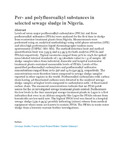| dc.contributor.author | Sindiku, Omotayo | |
| dc.contributor.author | Orata, Francis | |
| dc.contributor.author | Weber, Roland | |
| dc.contributor.author | Osibanjo, Oladele | |
| dc.date.accessioned | 2021-06-09T07:10:15Z | |
| dc.date.available | 2021-06-09T07:10:15Z | |
| dc.date.issued | 2013-07-03 | |
| dc.identifier.uri | https://doi.org/10.1016/j.chemosphere.2013.04.010 | |
| dc.identifier.uri | https://www.sciencedirect.com/science/article/abs/pii/S0045653513005249 | |
| dc.identifier.uri | http://r-library.mmust.ac.ke/123456789/1658 | |
| dc.description.abstract | Levels of seven major perfluoroalkyl carboxylates (PFCAs) and three perfluoroalkyl sulfonates (PFSAs) were analyzed for the first time in sludge from wastewater treatment plants from Nigeria. Measurements were performed using an analytical methodology using solid-phase extraction (SPE) and ultra high performance liquid chromatography tandem mass spectrometry (UHPLC–MS–MS). The method detection limit and method quantification limit was 3 pg/g and 9.5 pg/g for both analytes (PFCAs and PFSAs) respectively. Typical recoveries ranged from 50% to 104% for spiked mass labeled internal standards of 1 ng (absolute value) to 1 g of sample. All sludge samples taken from industrial, domestic and hospital wastewater treatment plants contained measurable levels of PFASs. Levels of the quantified perfluoroalkyl carboxylates and perfluoroalkyl sulfonates concentrations ranged from 10 to 597 and 14 to 540 pg/g, respectively. The concentrations were therefore lower compared to sewage sludge samples reported in other regions in the world. Perfluoroalkyl carboxylates with carbon chain having ⩾8 fluorinated carbons were detected in the analyzed sewage sludge samples at higher levels compared to carboxylates with <8 fluorinated carbon chain. The measured concentrations indicate that no PFAS point source for the 10 investigated sewage treatment plants existed. Furthermore the low levels in the four municipal sewage treatment plants in Lagos is a first indication that even in an African megacity like Lagos the PFASs release from households are low until now. The highest PFOS level was found in a hospital sewage sludge (539.6 pg/g) possibly indicating (minor) release from medical equipment where some are known to contain PFOS. The PFASs in waste water sludge from a brewery warrant further investigations. | en_US |
| dc.language.iso | en | en_US |
| dc.publisher | Chemosphere | en_US |
| dc.subject | Per- , polyfluoroalkyl, substances, sewage sludge | en_US |
| dc.title | Per- and polyfluoroalkyl substances in selected sewage sludge in Nigeria. | en_US |
| dc.type | Article | en_US |

